
Application Note
High-throughput imaging assays using zebrafish, a model organism for human disease
- Evaluate thousands of compounds in a few days in the complex 3-dimensional context of a whole organism
- Screen a wide range of disease and toxicity models
- Visualize and measure whole-body phenotypes in a single image
- Keep images in focus from head to tail with automated high-speed Z stacking
Why zebrafish screening?
Recently, zebrafish-based screening has gained favor as an alternative to mammalian screening due to cost, throughput and reduced ethical concerns. Zebrafish are a useful model for drug development because of their high biological similarity to humans. Studies in ontogeny and organogenesis have shown that their primary organ systems are very similar to humans, and the synteny between zebrafish and Homo sapiens is as high as 70-80%.
Zebrafish are beneficial for screening assays because of their high fecundity, transparency of embryos for viewing organ structures, and ease of gene manipulation. Their small size allows embryos to be placed in microtiter plates and treated with compounds. Phenotypes can then be measured on a high content screening system.
The ImageXpress® High-Content Screening System provides optimal flexibility for acquiring high quality images with a large field of view. MetaXpress® High Content Image Acquisition and Analysis Software enables image analysis for a wide range of applications with simple workflows, and in combination with AcuityXpress High Content Informatics Software for data mining, this end-to-end solution dramatically improves throughput for zebrafish-based in vivo screening.
Zebrafish-based in vivo high content screening applications
There has been a multitude of human disease models developed in zebrafish such as:
- Metabolic syndrome: obesity (visceral fat), dyslipidemia, fatty liver, glucose tolerance disorder
- Xenotransplantation of human cancer cells: tumor angiogenesis, distant metastasis
- Circulatory disease: cardiac failure, druginduced arrhythmia
- Central nervous system disorder: deafness, visual disturbance, smell disorder, epilepsy, developmental disorder, sleep arousal disorder, myodystrophy (ALS)
Several examples of how highcontent imaging assays can be used for investigating these disorders are shown here.
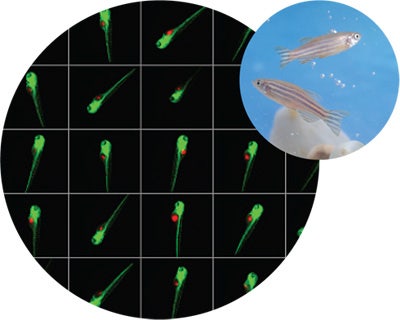
The data presented in this application note was provided by Prof. Toshio Tanaka, Department of Pharmacogenomics, Mie University Graduate School of Medicine.
Modeling tumor metastasis after xenotransplantation of human cancer cells1
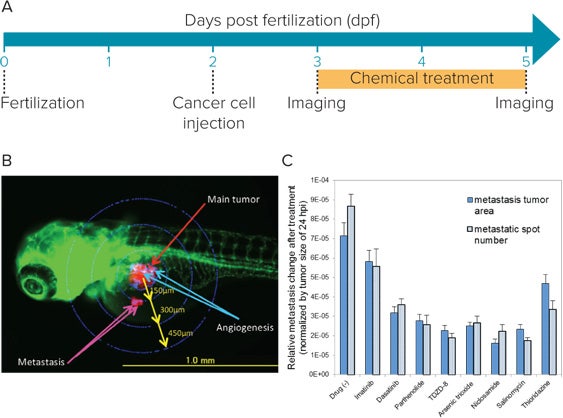
Figure 1. (A) Workflow for implanting human cancer cells in zebrafish. (B) Image of human leukemia stem cells labeled with Kusabira-orange (red) transplanted into Zebrafish embryo (green). (C) Measurement of tumor size and metastasis is graphed showing various levels of inhibition with different compounds.
Monitoring inhibition of angiogenesis
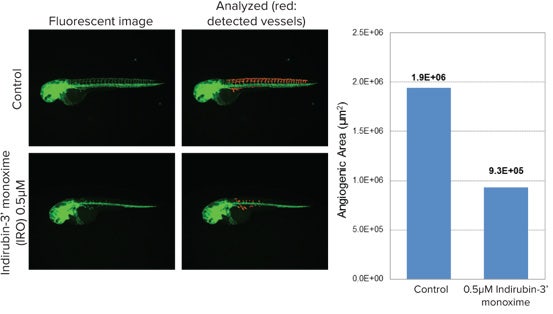
Figure 2. Zebrafish expressing GFP in vascular endothelial cells were exposed to compounds for 12-48 hours. The intersegmental vessels, thin dorsal and ventral vessels emerging from the main trunk, were measured using the Angiogenesis Tube Formation application module of MetaXpress Software. Inhibition of angiogenic vessel growth is evident upon compound treatment.
Cardiac function analysis
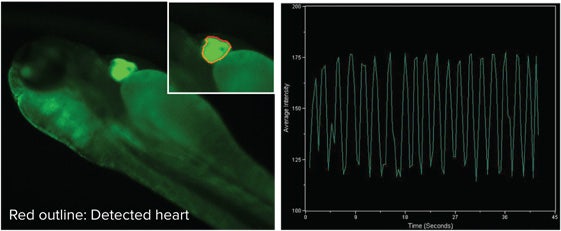
Figure 3. Cardiac function in transgenic zebrafish with cells expressing a GFP-tagged protein in the heart is measured by outlining the heart as a region-of-interest and using time-lapse imaging to measure the change in area or intensity over time as the heart beats. MetaXpress displays the intensity fluctuations over time.
Gene knockdown quantitation2

Figure 4. Lissamine fluorescence was used to correlate the amount of injected morpholino antisense oligonucleotide (MO) with the level of gene knockdown.
Measuring ototoxicity

Figure 5. The destruction of zebrafish hair cells has been used an indicator of ototoxicity. After treating zebrafish with toxic compounds known to cause ototoxicity, fluorescently-labeled hair cells were measured using a spotcounting algorithm.
Identifying neurotoxicity
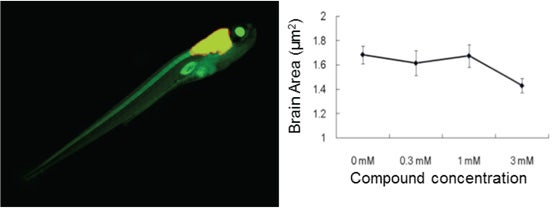
Figure 6. Zebrafish with fluorescently-labeled neurons (yellow in image) were treated with neurotoxic compounds and the brain area affected by the exposure was measured as an indicator of neurotoxicity. At a high dose of compound the measured fluorescent brain area was significantly smaller than in the untreated control embryos.
Targeted image acquisition of a specific area of the well or zebrafish
For objects that may not be in the same area of every well, targeted imaging can be used to pinpoint the object of interest using low magnification and then return to those coordinates to acquire a higher magnification image.
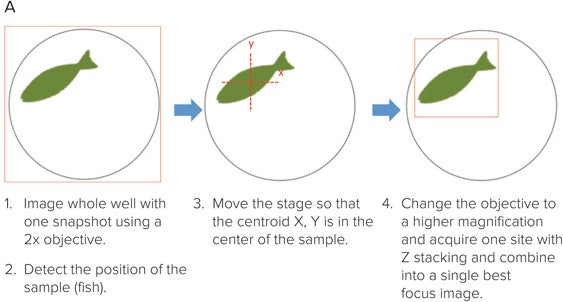
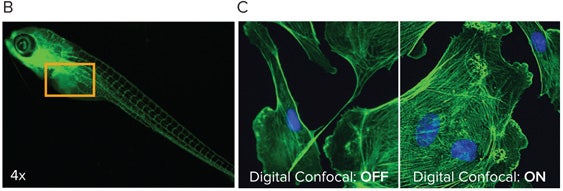
Figure 7. Entire fish imaged in one field-of-view. (A) To achieve a completely in-focus image, multiple z-planes were acquired and combined using a best-focus algorithm. (B) The area-of-interest (orange outline) was then re-acquired at high magnification. (C) The Digital Confocal feature is an onthe-fly deconvolution method that can be used to improve resolution and facilitate more accurate segmentation of subcellular features.
Summary
Zebrafish embryos are a valuable vertebrate model for translational research. Using the ImageXpress High-Content Screening Systems to acquire images of zebrafish in focus from head to tail with a large field of view and high-speed z-stacking provides the ability to measure phenotypes characteristic of disease or toxicity. High-throughput in vivo imaging of zebrafish in combination with MetaXpress High-Content Analysis software empowers laboratories to increase their throughput dramatically and screen thousands of compounds in just a few days. Set up and run automated imaging screens to monitor inhibition of angiogenesis, quantitate gene knockdown, and measure ototoxicity and neurotoxicity with this end-to-end solution.
References
1. Zhang, B., et al., Quantitative phenotyping-based in vivo chemical screening in a zebrafish model of leukemia stem cell xenotransplantation, PLoS One, 2014 Jan 15; 9(1).
2. Umemoto, N., et al., Fluorescent-based methods for gene knockdown and functional cardiac imaging in zebrafish, Mol Biotechnol, 2013 Oct; 55(2): 131-42.
3. Kanungo, J., et al., In vivo imaging and quantitative analysis of changes in axon length using transgenic zebrafish embryos. Neurotoxicol Teratol, 2011 Nov-Dec; 33(6): 618-23.
4. Diekmann, H., et al., Characterization of optic nerve regeneration using transgenic zebrafish. Front Cell Neurosci, 2015 April 9; 9:118.
5. Huan, H., et al., High-throughput screening for bioactive molecules using primary cell culture of transgenic zebrafish embryos. Cell Rep, 2012 Sep 27; 2(3):695-704.
为什么使用斑马鱼进行筛选?
目前,基于斑马鱼的筛选由于花费,通量和伦理原因作为一种哺乳动物筛选的替代受到欢迎。
斑马鱼由于其与人类的高度生物相似性, 成为一种有用的药物开发模型。在个体学 和器官形成研究中体现了其主要器官系统 与人类极其相似,且斑马鱼和人类的相似 度高达 70 - 80%。
斑马鱼由于其繁殖力强,胚胎透明能看到器官结构且易于基因操作的特性对筛选有益。由于其体积小,所以可以放入微孔板中用化合物处理。然后表型能使用高内涵筛选系统来进行检测。
ImageXpress® 高内涵筛选系统提供更好的 灵活性来拍摄大视野的高质量图像。
MetaXpress® 高内涵图像获取和分析软件 允许以简单的工作流程来实现宽范围的实 验应用的图像分析。并且结合用于数据挖 掘的 AcuityXpress 高内涵信息学软件, 这种端到端的解决方案显著的增强了基于 斑马鱼的体内实验的通量。
基于斑马鱼的体内实验应用
有大量的已开发的人类疾病斑马鱼模型如:
- 代谢综合症: 肥胖 ( 内脏肥胖 ),血脂异 常,脂肪肝,糖耐受失调
- 人类癌症细胞异种移植:肿瘤血管生成, 远端转移
- 循 环 疾 病 : 心 力 衰 竭 , 药 物 诱 导 的 心 率失调
- 中央神经系统失调: 耳聋,视力障碍, 嗅觉失调,癫痫,发育紊乱,睡眠唤 醒障碍,肌营养不良 (ALS)
一系列例子能用来展示如何将高内涵用于研究以上失调。

The data presented in this application note was provided by Prof. Toshio Tanaka, Department of Pharmacogenomics, Mie University Graduate School of Medicine.
人类肿瘤细胞异种移植后的转移模型
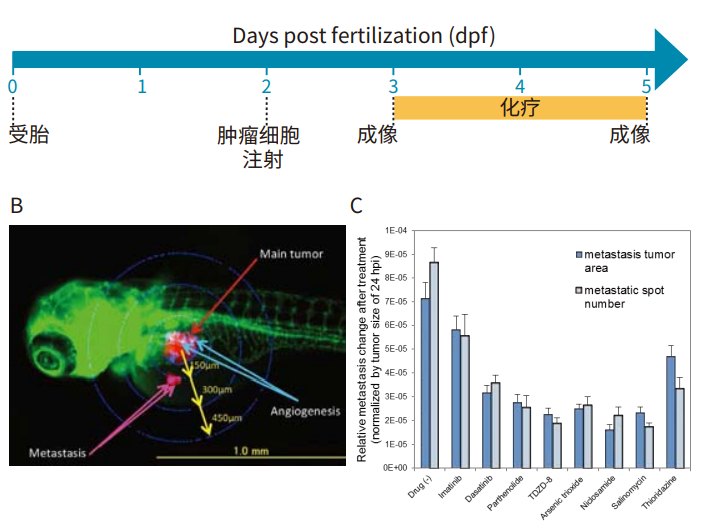
图 1 (A) 斑马鱼植入人肿瘤细胞工作流程。(B) 标记 Kusabira-orange ( 红 色 ) 的人白血病干细胞移植入斑马鱼胚胎的图像 ( 绿色 )。(C) 测量肿瘤大小 和转移并于柱状图中展示不同化合物的抑制程度。
显示抑制血管生成
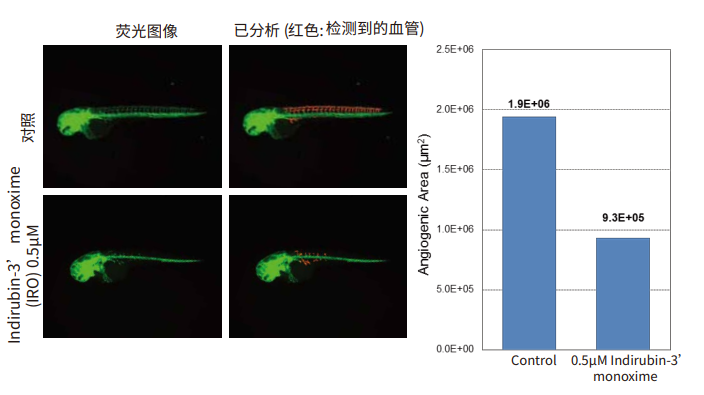
图 2 血管上皮细胞表达GFP的斑马鱼暴露在化合物中 12 - 48 小时。节间 血管,细的背部和腹部血管和躯干区分开,使用 MetaXpress 软件血管生 成应用模块分析。生成的血管生长在化合物处理后明显抑制。
心脏功能分析
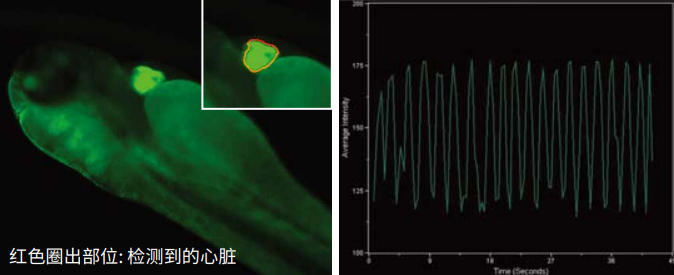
图 3 心脏中带有表达 GFP 标记蛋白的细胞的斑马鱼的心血管功能通过将 心脏圈出来作为所关心的区域并时序拍摄并测量面积和亮度随时间的变化 来表示心跳。MetaXpress 展示荧光随时间的波动。
基因敲除定量2

图 4 丽丝胺荧光用于表示与注射的反义吗啉环寡核苷酸 (MO) 相关的敲除 程度。
测量耳毒性

图 5 斑马鱼毛发细胞的破坏可作为耳毒性的指示。对斑马鱼进行已知毒性化合物处理之后导致耳毒性,荧光标记的毛发细胞使用点计数算法测量。
鉴定神经毒性

图 6 以神经毒性化合物处理神经元标记了荧光的斑马鱼 ( 图像中的黄色 ) 并测量药物处理后的脑面积作为神经毒性的指示。在高浓度的化合物条件 下测量的荧光脑面积明显小于未处理的对照组胚胎。
孔中或斑马鱼特定区域靶目标图像获取
对于那些可能不在每个孔中相同区域物体,靶目标成像能够使用低放大倍数标记出关心的物体然后返回到相应坐标来拍摄更高放大倍数的图像。
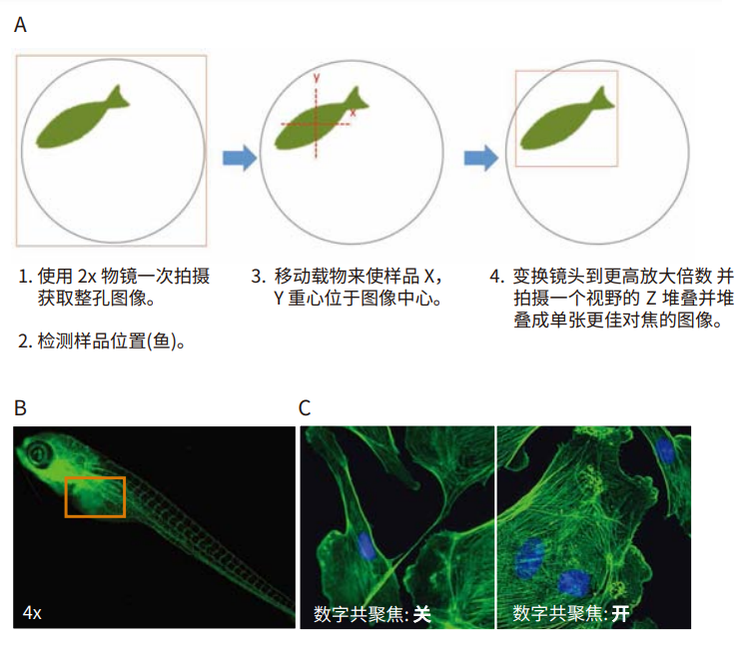
图 7. 单视野完整鱼成像。(A) 为实现的完整的在焦图像,拍摄多 z 轴层面并 使用 best-focus 算法组合成一张图像。 (B) 关心区域 ( 橙色框 ) 使用高放大 倍数再次成像。(C) 数字共聚焦特性是一种实时反卷积方法能用来加强分辨 率并利于亚细胞结构分区。
总结
斑马鱼胚胎作为一种有价值的表达研究脊椎动物模型。使用 ImageXpress 高内涵筛选系统来,再焦的、从头到脚大视野拍摄斑马鱼并高速 Z 轴 系列堆叠成像,这种能力可实现检测疾病或毒性表型测量。高内涵进 行斑马鱼体内成像并结合 MetaXpress 高内涵分析软件强显著的增加通 量来强化实验室,并使其几天筛选成千上万的化合物。建立并运行自 动化成像筛选来显示血管生成的抑制,定量基因敲除,并以端到端的 解决方案来检测耳毒性和神经毒性。
参考文献
1. Zhang, B., et al., Quantitative phenotyping-based in vivo chemical screening in a zebrafish model of leukemia stem cell xenotransplantation, PLoS One, 2014 Jan 15; 9(1).
2. Umemoto, N., et al., Fluorescent-based methods for gene knockdown and functional cardiac imaging in zebrafish, Mol Biotechnol, 2013 Oct; 55(2): 131-42.
3. Kanungo, J., et al., In vivo imaging and quantitative analysis of changes in axon length using transgenic zebrafish embryos. Neurotoxicol Teratol, 2011 Nov-Dec; 33(6): 618-23.
4. Diekmann, H., et al., Characterization of optic nerve regeneration using transgenic zebrafish. Front Cell Neurosci, 2015 April 9; 9:118.
5. Huan, H., et al., High-throughput screening for bioactive molecules using primary cell culture of transgenic zebrafish embryos. Cell Rep, 2012 Sep 27; 2(3):695-704.